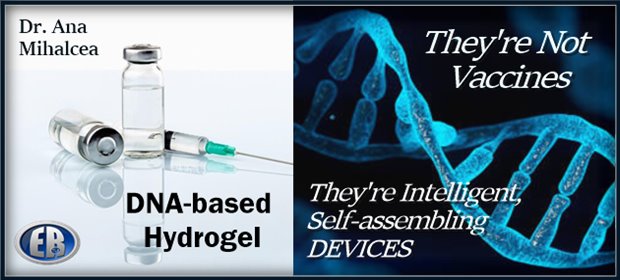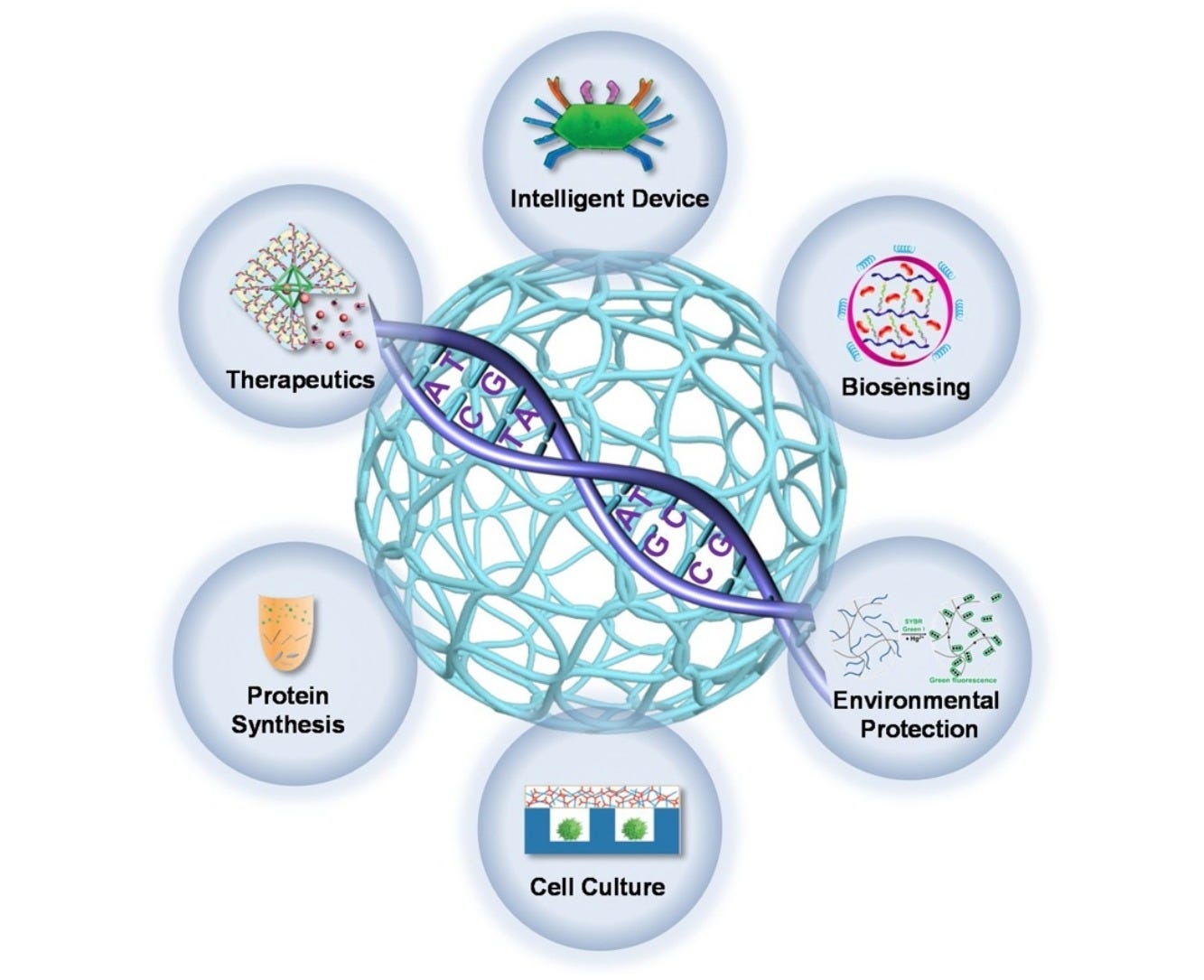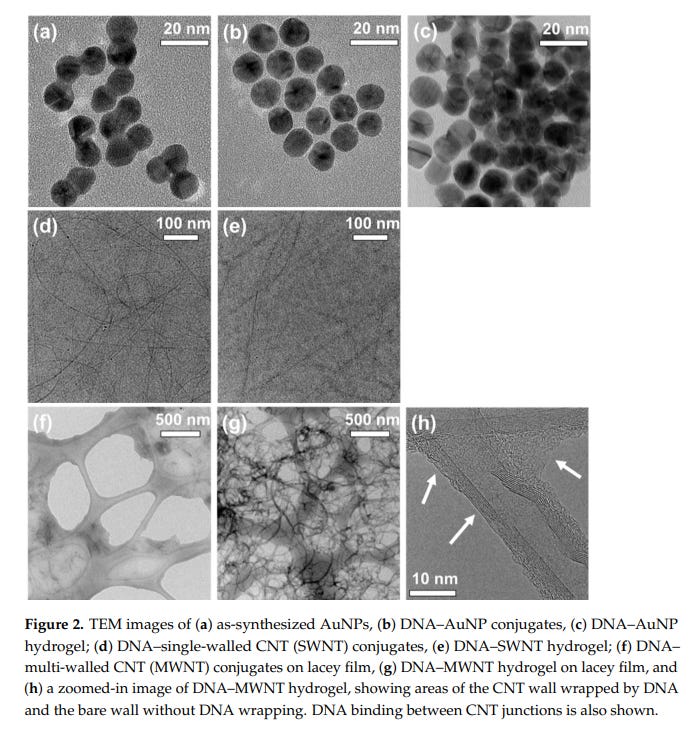
ER Editor: We know the fake doctors in the medical truth movement as, generally speaking (not all), those who represent the Covid injection issues as biological only, i.e. the spike proteins, etc. We remind readers that some injections have been found to have ZERO biological ingredients. Some with biological components have also been found to have synthetic ingredients, usually containing graphene oxide and toxic nanolipids.
We’re trying to get our heads around the synthetic components, which seem to blend with our biology – our very cells. A focus here is our DNA, a phenomenal ‘stuff” that is immensely programmable to perform in different ways and has truly massive storage capacity. Hydrogel, a synthetic product, is capable of the same functions, however. Hydrogel in combination with carbon nanotubes and metals produce electronic hardware.
**
To give us an idea of how hydrogel and human tissue combine, check out Tissue engineering: Strong hydrogel carries current – Supporting a hydrogel with a carbon-nanotube network helps to grow muscle tissue for medical applications
Just to be clear, human tissue is being grown using toxic hydrogel and graphene oxide, which is capable of carrying an electrical current.
See this by Dr. Mihalcea on how hydrogel is medically used to stop bleeding by creating clotting:
Hydrogel Coagulates Blood and Causes Blood Clots
Below Dr. Mihalcea talks about DNA-based hydrogel:
It is important to understand that this Hydrogel based on DNA now can be seen as a protein factory, a sensing or otherwise intelligent technological DEVICE. This is what Karen Kingston has been discussing as well, the C19 shots are DEVICES, not vaccines.
********
How To Create Self Assembled Nanocircuits aka Technological Devices From DNA Hydrogel, Carbon Nanotubes and Metals

Image Source: Polymeric DNA hydrogel: Design, synthesis and applications
.
Hydrogel is in C19 injectables and other medical supplies, in chemtrails, in the food supply. The ramification of this is profound, as Hydrogel is a technological platform that is programmable matter with self assembly capabilities – it can mimic any cell type and synthetically replace the structure of biological cells with synthetic artificial intelligence machines – or technological devices – while using biological “ natural” materials.
Because the synthesis of biology with technology for many people, including doctors, is a novel concept, the realities of such ideas are very challenging for people to understand. The capability of harnessing biology for technological advances provides access to phenomenal possibilities, which actually demonstrates in my mind how miraculously divine we are in our natural unadulterated form. The human body in its remarkable makeup and functioning is truly a divine creation.
The transhumanist synthetic biology trend wants to hijack that miracle, reprogram it and make it work for its purpose in its image of twisted dark AI hybridization. This approach seems so cutting edge innovative, and yet unfortunately we know that this approach can and has been weaponized.
In this article I wish to provide some very basic “how is it done explanations”, that are worth reviewing and everyone should familiarize themselves with these concepts. We must know and understand what is really happening to the human species, so we can begin to adequately address the problem of facing a technological advance decades ahead of mainstream understanding in its execution. If that is not fundamentally done in the information flow, the continued smoke and mirrors approach does not allow us to make progress in fighting on a vitally important front of the war – that must be addressed for the survival of the genetic human species. In my mind, not addressing the Nanotechnology, synthetic biology and transhumanist agenda is fighting a war on the sidelines while ignoring the main front of the battle.
My take away message is this: from Hydrogel, Carbon Nanotubes (Graphene) and Metals you can create electronic hardware. Once you understand that these components have been found in the C19 injections, you may be able to look at the Nanotechnology discussion from a different viewpoint.
Back to some basics. First, many natural molecules, like our own DNA, are actually self assembly polymers, just like Hydrogel. DNA is a versatile molecule with phenomenal information storage capacity.
Here are some numbers for your perspective:
DNA can archive a staggering amount of information in an almost inconceivably small volume. Consider this: humanity will generate an estimated 33 zettabytes of data by 2025—that’s 3.3 followed by 22 zeroes. DNA storage can squeeze all that information into a ping-pong ball, with room to spare. The 74 million million bytes of information in the Library of Congress could be crammed into a DNA archive the size of a poppy seed—6,000 times over. Split the seed in half, and you could store all of Facebook’s data.
Science fiction? Hardly. DNA storage technology exists today, but to make it viable, researchers have to clear a few daunting technological hurdles around integrating different technologies. As part of a major collaboration to do that work, our team at Los Alamos National Laboratory has developed a key enabling technology for molecular storage. Our software, the Adaptive DNA Storage Codex (ADS Codex), translates data files from the binary language of zeroes and ones that computers understand into the four-letter code biology understands.
Source: Scientific American:
As mentioned, DNA itself is a self assembly polymer, which is what hydrogel also is. In fact there can be DNA based Hydrogels:
Deoxyribonucleic acid (DNA) stores genetic information as a biomolecule, and also is regarded as a block copolymer and polyanion. Under favorable environments, DNA polymeric chains can spontaneously self-assemble into well-defined secondary or even higher ordered structures by following Watson-Crick base-paring rules, thus making DNA a competitive alternative in the fabrication of materials with precisely designed molecular structure and tailored functions.
This means you can encode DNA with any information, and get it to do anything. You can make a yeast DNA produce petroleum. You can have a spike protein sequence make Hydrogel. These is no limit to this capability, as DNA is simply the language that encodes the action of production. It is a computer hardware and software if you want to see it that way. This software of life is what the Globalists know is hackable.
The review article continues:
Among DNA based materials, DNA hydrogels comprising three-dimensional networks of DNA polymeric chains, have received considerable attention as a new class of polymeric materials particularly as biomaterials, showing great potential in a wide range of promising applications.
It is important to understand that this Hydrogel based on DNA now can be seen as a protein factory, a sensing or otherwise intelligent technological DEVICE. This is what Karen Kingston has been discussing as well, the C19 shots are DEVICES, not vaccines.
Representative applications in biosensing, therapeutics, protein production, cell culture, intelligent device, and environmental protection are exemplified to show how DNA hydrogels are rationally and exquisitely designed to address application issues.
Polymeric DNA hydrogel: Design, synthesis and applications
How do you create a technological Device out of DNA Hydrogel, Carbon Nanotubes ( Graphene), and metal particles?
Molecular self-assembly of DNA has been developed as an effective construction strategy for building complex materials. Among them, DNA hydrogels are known for their simple fabrication process and their tunable properties. In this study, we have engineered, built, and characterized a variety of pure DNA hydrogels using DNA tile-based crosslinkers and different sizes of linear DNA spacers, as well as DNA hydrogel/nanomaterial composites using DNA/nanomaterial conjugates with carbon nanotubes and gold nanoparticles as crosslinkers. We demonstrate the ability of this system to self-assemble into three-dimensional percolating networks when carbon nanotubes and gold nanoparticles are incorporated into the DNA hydrogel. These hydrogel composites showed interesting non-linear electrical properties. We also demonstrate the tuning of rheological properties of hydrogel-based composites using different types of crosslinkers and spacers. The viscoelasticity of DNA hydrogels is shown to dramatically increase by the use of a combination of interlocking DNA tiles and DNA/carbon nanotube crosslinkers. Finally, we present measurements and discuss electrically conductive nanomaterials for applications in nanoelectronics.
Studies have described strategies for coating and crosslinking nanomaterials such as quantum dots, nanoparticles, and nanotubes with DNA to create a variety of water soluble heterostructured conjugates. Using these DNA/nanomaterial conjugates as integral building blocks of crosslinked molecular networks has led to interesting DNA hydrogel composites assembled with oligonucleotides and other nanomaterials. Integration of nanomaterial conjugates makes it possible to modify the hydrogel properties to engineer mechanically and electrically adjustable materials. However, the electrical properties of hydrogel composites bearing embedded conductive nanomaterials have rarely been studied, and there is a need for a deeper understanding of DNA as a building material to assemble 3D nanocircuits with conductive nanomaterials. One such material is carbon nanotubes (CNTs). CNTs are known for their utility in reinforcing nanofiber networks due to their excellent mechanical strength and stiffness. They are chemically stable and have high aspect ratios that contribute to electrical percolation in nanocomposites, which makes CNTs a promising material in nanoelectronics applications. However, bare CNTs naturally have low solubility in aqueous solutions in the absence of surfactants or sidewall functionalization . One method to effectively solubilize CNTs is via biomolecular dispersion, where single-stranded DNA (ssDNA) wraps around individual nanotubes via the strong non-covalent hydrophobic interactions between CNT walls and DNA nucleobases to form water-soluble supramolecular complexes. Besides improving solubility and manageability, the DNA–CNT hybrids also combine the advantageous electrical and mechanical properties of CNTs and the molecular recognition capabilities of DNA.
The unusual electrical and mechanical properties of hydrogel, Carbon nanotubes and metals allow the production of highly efficient Nano scale machines:
We also showed that the 3D structures of nanomaterials can be programmed efficiently via nucleic acid sequence, and that it is possible to direct the formation of percolating networks with DNA self-assembly. In addition, using inspiration from biological neural networks that display extraordinary signal dynamics and processing abilities, we aimed to mimic some aspects of the morphology of natural neural networks using DNA self-assembly to fabricate nanoelectronic devices with measurable function. Non-linear electrical properties of nanocomposites that integrate DNA-modified CNTs are reported. Our eventual goal is to harness molecular recognition to precisely control the configuration and connection of nanomaterials to self-assemble into controllable nanostructures and, thus, to engineer, fabricate, and characterize DNA-based hydrogels for desired applications. Future DNA hydrogel composites may find impactful application as building blocks in artificial computer hardware, with architectures inspired by natural neural systems for memory and information-processing applications.


They have found highly unusual electrical behaviors – the electrical conductivity increased by 650 fold with spacers. Imagine what would happen to a human body if you inject hydrogels and increase the electrical conductivity by 650 fold. What happens to biological processes?
As shown in Figure 5a, dehydrated samples of DNA–SWNT conjugates and DNA– SWNT hydrogel both showed non-linear behaviors. With the same applied voltage pulses, the measured current increased greatly in the hydrogel samples with spacers compared to DNA–SWNT conjugates—over a 650-fold increase. Since MWNTs are highly conductive, they showed a wire-like behavior with a much higher conductivity compared to the SWNT samples. In the MWNT case, adding DNA spacers also increased the conductivity of DNA– MWNT conjugates by 45-fold—see Figure 5b. When testing with DNA–AuNP samples, the current increased four-fold after adding spacers to the conjugates and forming gel-like networks, as shown in Figure 5c. These electrical measurements demonstrate that modification and organization of nanomaterials using DNA strands can be used to control the electrical behavior of percolating networks and can change the conductivity of composites by using DNA self-assembly to connect the nanomaterials.
In other words, the modification of DNA Hydrogel with carbon nanotubes and gold metal created semiconducting behavior. You now have an electrical programmable machine or device.
Studies on the conductivity of DNA mostly agree that DNA is not a good conductor and does not contribute to conductivity in composites when conductive nanomaterials are present [51]. However, DNA has been seen as a good candidate to self-organize nanocircuits into a complex system. Therefore, besides mechanical reinforcement, another objective of integrating nanomaterials into the hydrogel composites is to modify the electrical behavior and add functionality to the hydrogels. For this reason, we used semiconducting SWNTs when making DNA–SWNT conjugates. In a previous electrical study of a single SWNT on parallel gold electrodes [52], the IV curves showed a saturation of conductance at high voltages
Conclusions – This Nanotechnology can create highly effective ELECTRONIC HARDWARE
We showed the ability of DNA self-assembly to integrate and connect percolating networks with nanotubes and nanoparticles. These initial examples of biomolecular functionality by design suggest that the basic concepts of DNA self-assembly can effectively be used to create more complicated materials. Potentially, crosslinkers such as DNA-wrapped CNTs can be used to create more sophisticated conjugates and nanostructures. We can design DNA to realize control in nanoelectronics morphology through connection and arrangement of nanomaterials. These materials have potential for applications in 3D integrated circuits and hardware with shorter production time, lower cost, lower power consumption, and higher energy efficiency. Eventually, electronic hardware utilizing 3D integration and assembled using DNA nanotechnology may achieve computing capabilities in certain operations beyond the performance currently achieved by circuits fabricated using traditional lithography techniques.
************
Source
Featured image, DNA: https://psychiatry.pitt.edu/jama-psychiatry-genetic-variants-are-associated-risk-bipolar-disorder

••••
The Liberty Beacon Project is now expanding at a near exponential rate, and for this we are grateful and excited! But we must also be practical. For 7 years we have not asked for any donations, and have built this project with our own funds as we grew. We are now experiencing ever increasing growing pains due to the large number of websites and projects we represent. So we have just installed donation buttons on our websites and ask that you consider this when you visit them. Nothing is too small. We thank you for all your support and your considerations … (TLB)
••••
Comment Policy: As a privately owned web site, we reserve the right to remove comments that contain spam, advertising, vulgarity, threats of violence, racism, or personal/abusive attacks on other users. This also applies to trolling, the use of more than one alias, or just intentional mischief. Enforcement of this policy is at the discretion of this websites administrators. Repeat offenders may be blocked or permanently banned without prior warning.
••••
Disclaimer: TLB websites contain copyrighted material the use of which has not always been specifically authorized by the copyright owner. We are making such material available to our readers under the provisions of “fair use” in an effort to advance a better understanding of political, health, economic and social issues. The material on this site is distributed without profit to those who have expressed a prior interest in receiving it for research and educational purposes. If you wish to use copyrighted material for purposes other than “fair use” you must request permission from the copyright owner.
••••
Disclaimer: The information and opinions shared are for informational purposes only including, but not limited to, text, graphics, images and other material are not intended as medical advice or instruction. Nothing mentioned is intended to be a substitute for professional medical advice, diagnosis or treatment.






Leave a Reply